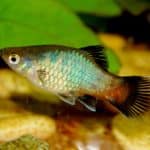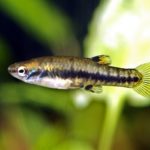We all know that buying fish can be a bit of a gamble. But what if you knew enough about the fish you were buying to ensure it would survive?
Unfortunately, this is something that many people don’t do, and as a result, their fish die shortly afterwards. Lucky for you – this guide discusses some things you should know before buying a Rainbow Darter to avoid this.
Rainbow Darters (Etheostoma caeruleum) are an impressively colorful fish native to North America. They are common throughout the United States, specifically along the Great Lakes and Ohio River. They can also be found in some regions of Canada.
These fish feature an elongated body (typical of the goby) and beautiful, contrasting, vivid colors. Keep reading to learn more about the Rainbow Darter and how to care for them properly.
Species Summary
Distributed over a wide area of North America, the Rainbow Darter is a species of freshwater darter belonging to the Percidae family.
Rainbow darters are one of the most colorful darters, and they are found in various habitats. The species occurs in waters of moderate to strong flow (lotic environment) and are found in small rivers and streams of clear and cold water; they are usually found between rocks and the substrate’s gravel.
They grow large enough to be kept in small aquariums; however, it presents some difficulties in their maintenance, mainly about the water quality.
The main reason why people enjoy looking at these fish is because of their vibrant and contrasting colors. Even though they’re among the most desirable fish, they’re still relatively uncommon in home aquariums worldwide. Their popularity, production, and commercialization are practically restricted to hobbyists who, for the most part, live near the collection sites.
Rainbow Darter Care Guide
These fish are quite adaptable and can be kept in community aquariums with no issues. Like other darters, they inhabit fast, cold, well-oxygenated waters. They’re solitary animals, living quietly alone; however, when in larger groups, they display gregarious behaviour.
Rainbow darters are relatively easy to care for, but there are a few things you’ll need to keep in mind to ensure they stay healthy and happy. Here’s what you need to know about rainbow darter care:
Tank Size
Rainbow Darters are not very active fish, which spend most of their time holed up between rocks or close to the substrate. As a result, they can be kept in a tank with relatively small space.
A 48″ x 12″ aquarium or somewhere around 28 gallons is a good size to start with a small group. This size is recommended because of the ease of maintaining water quality. But like most fish, the bigger the tank, the better their health.
Tank Mates
They are peaceful fish who live peacefully alongside other small and friendly fish. However, you should keep these fish with tank mates that need the same life condition as the Rainbow Darter. These include, native killifish, minnows, catfish, northern redbelly dace, zebra danios, and loaches.
A word of caution: Do not keep Rainbow Darters with large, territorial, and aggressive fish because they may be harassed or killed. These include great blue heron, smallmouth bass, large stonecats, and burbot. Remember, Rainbow Darters are small fish and do not have the strength or fighting ability to defend themselves against larger fish.
Same Species Tanks
Rainbow darters are generally peaceful fish, but they can be territorial with their own species. So if you’re keeping more than one Rainbow Darter, it’s best to provide them with plenty of hiding places and to keep a close eye on them until you’re sure they’re getting along.
Water Parameters
Rainbow darters are tolerant of a wide range of water conditions, but there are a few things to keep in mind. First, the water in their habitat should be clean and well-oxygenated, with a pH between 6.0 and 8.0. The temperature should be kept between 50 and 66 degrees Fahrenheit. Meanwhile, the hardness should be controlled between 8 and 20°H.
What to Put in Their Tank
As mentioned, Rainbow Darters can be found in a variety of habitats. In the wild, they typically inhabit areas with lots of vegetation, providing them with hiding places from predators. Therefore, when creating a habitat for your Rainbow Darter, include plenty of plants (natural or artificial) and some rocks or other decorations for them to hide among.
That’s right. Keeping a Rainbow Darter happy means providing plenty of plant matter, hiding spots, and open swimming areas.
But that’s not all; a good filter and reliable heater are essential for these fish. Rainbow Darters need clean water with a good oxygen level and temperature around 50-66 degrees Fahrenheit.
Common Diseases
One of the most common diseases that affect the Rainbow Darter is Ich. Ich is caused by a parasite that attaches to the fish’s skin and fins. The parasite can cause the fish to scratch itself, which can lead to secondary infections. Ich can be treated with medication, but it is best to prevent it with good tank maintenance.
Another common disease that affects the Rainbow Darter is bacterial gill disease. This disease is caused by bacteria that infect the gills. The bacteria can cause the gills to become red and inflamed. Gill disease can be treated with medication, but it is best to prevent it with good tank maintenance.
The Rainbow Darter is also susceptible to fungal infections. These infections are usually found on the fins and body. They can be treated with medication, but good tank maintenance is best to prevent them.
It’s pretty obvious once you think about it – proper tank maintenance is the best way to prevent diseases in the Rainbow Darter. The tank should be kept clean, and the water should be filtered.
Food and Diet
If you’re still reading this guide, you’re probably interested in learning more about the Rainbow Darter diet. Well, the diet of the rainbow darter is quite interesting.
These fish are primarily carnivorous, feeding on small invertebrates such as insects and crustaceans. However, they will also consume plant matter and algae from time to time. This diet helps them to stay healthy and vibrant.
However, it’s essential to provide a variety of foods to ensure that the Rainbow Darter gets all the nutrients it needs. One way to do this is to offer live food, such as small worms or brine shrimp. You can also provide frozen or freeze-dried foods, which can be found at most pet stores.
Lifespan
The lifespan of a Rainbow Darter is relatively short, rarely living beyond the age of 3. However, in that short time, they are one of the most vibrant and beautiful fish in the freshwater aquarium trade.
Appearance
The Rainbow Darter is a stocky-bodied darter with three dark crossbars across the back, often interspersed with 1 to 7 less distinct bars. The back is mottled brown with transverse bars or dark brown spots.
Additionally, the sides are lighter brown with a series of blue-green bars (best developed on the posterior half of the body). The spiny dorsal is dark at the base; the soft dorsal and caudal fins are slightly streaked with brown lines.
Size
The Rainbow Darter fish can easily reach 3.1 inches in length when well cared for and fed. Usually, the average size we find in aquariums is around 1.9 inches.
Behavior and Temperament
They are shy fish that spend most of their time hiding among rocks waiting for prey, although they can become active swimmers depending on the aquarium setup. They intimidate their opponents by shaking their gills and emitting pheromones when they suffer an injury to their skin, serving as a warning of danger to their congeners.
Their behavior can change if they feel comfortable hiding among vegetation, rocks, and driftwood in the tank. While not necessarily aggressive towards other fish species, Rainbow Dartes may display specific territoriality or aggression among their species.
The Rainbow Darter fish can easily reach 3.1 inches in length when well cared for and fed. Usually, the average size we find in aquariums is around 1.9 inches.
Breeding
Contrary to what is said, its reproduction in captivity is relatively simple, as long as you provide the ideal living conditions for the fish. As oviparous species, its reproduction is similar to the vast majority of other darters. Parents do not display parental care, and cannibalism over eggs and fry is common.
In their natural environment, they spawn between March and June. Larvae hatch between 10 and 12 days at an average temperature of 64 F.
The transition from larval to juvenile stages occurs between 18 and 21 days. Females of this species migrate to where the males are holed up and spawn numerous times. The brightly colored males set up their loose territories around rocks or depressions in the gravel of a riffle with the medium current.
After choosing the male, they begin the spawning process with the female releasing the eggs and the male releasing the sperm. This process is repeated countless times until another male disturbs them.
In addition, when a female enters a territory, the male swims to her and pokes her sides with his snout. She then buries herself partially under the gravel if she is ready to spawn. The male lies upon her; she vibrates and deposits her eggs while the male fertilizes them.
Once fertilized, the eggs are buried. Females can lay 800 eggs over several days.
Gender Differences: Male vs. Female
The Rainbow Darter is sexually dimorphic, with males larger than females during the breeding season. Males also significantly change color tone, acquiring solid and vibrant colors. The colors on the males are so bright that they’re thought to help the fish attract mates.
As well as being more colorful, male Rainbow Darters are more territorial than their female counterparts.
Rainbow Darter Fun facts
● Like other darters, it can maintain a fixed position close to the substrate, even under strong water currents. This characteristic plays a crucial role in their preference for streams and rivers with rapids and rocky substrate.
● It presents intolerance to the presence of salt in water and pollution, and human-induced changes such as pollution itself or sewage drainage can negatively impact its abundance.
● They can detect each other’s chemical signals and behaviors. For example, in a situation where a predator is attacking a rainbow archer, it can release a chemical pheromone that alerts other members of its species of danger once the skin has been torn. Other darters respond to this alert by decreasing their activity and burrowing, making themselves less detectable by predators.
● They respond aggressively to their peers by flapping their gills, like other Gobies. As a result, they are seen as competitors and a threat to their territory and food supply. Males and females use their colors to communicate, especially during the breeding season.
● Considered a cold-water fish, its life expectancy decreases considerably when exposed to tropical temperatures.
Final Words
If you’re thinking of adding a Rainbow Darter to your tank, we say go for it! They are beautiful fish that are truly a rainbow of colors. Just be sure to provide them with plenty of hiding places, and you’ll have a happy and thriving Rainbow Darter in your home aquarium.
References.
Nelson, J.S., E.J. Crossman, H. Espinosa-Pérez, L.T. Findley, C.R. Gilbert, R.N. Lea and J.D. Williams, 2004. Common and scientific names of fishes from the United States, Canada, and Mexico. American Fisheries Society, Special Publication 29, Bethesda, Maryland. ix, 386 p. + 1 CD.
Baensch, H.A. and R. Riehl, 1991. Aquarien atlas. Bd. 3. Melle: Mergus, Verlag für Natur-und Heimtierkunde, Germany. 1104 p.
Hugg, D.O., 1996. MAPFISH georeferenced mapping database. Freshwater and estuarine fishes of North America. Life Science Software. Dennis O. and Steven Hugg, 1278 Turkey Point Road, Edgewater, Maryland, USA.
Page, L.M. and B.M. Burr, 1991. A field guide to freshwater fishes of North America north of Mexico. Houghton Mifflin Company, Boston. 432 p.








